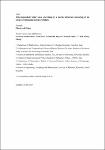Time-dependent water wave scattering by a marine structure consisting of an array of compound porous cylinders
| dc.contributor.author | Bora, SN | |
| dc.contributor.author | Das, S | |
| dc.contributor.author | Meylan, MH | |
| dc.contributor.author | Saha, S | |
| dc.contributor.author | Zheng, S | |
| dc.date.accessioned | 2023-06-13T08:16:05Z | |
| dc.date.available | 2023-06-13T08:16:05Z | |
| dc.date.issued | 2023-07-01 | |
| dc.identifier.issn | 1070-6631 | |
| dc.identifier.issn | 1089-7666 | |
| dc.identifier.other | ARTN 077103 | |
| dc.identifier.uri | https://pearl.plymouth.ac.uk/handle/10026.1/20967 | |
| dc.description.abstract |
Under the assumption of linear wave theory, a semi-analytical model is developed to address the time-dependent water wave scattering problem involving a marine structure consisting of several circular rigid vertical cylinders, each of which is surrounded by a thin cylindrical porous wall with a water region between the inner cylinder and the wall. The problem is tackled by applying the eigenfunction expansion approach. The energy dissipation relation is also derived for the system of compound cylinders. The principal focus of this work lies in locating the optimum geometrical configurations for which the wave forces acting on the structure are minimal along a given wave direction in the frequency domain. Subsequently, the time-dependent response of the structure under the impact of a Gaussian wave pulse is examined. The wavenumber at which the force acting on the inner cylinder is at its maximum is obtained for a given value of the porous-effect parameter. Moreover, the value of that corresponding wavenumber decreases as the magnitude of the porous-effect parameter increases. The model is also carefully validated numerically against results available in the existing literature. | |
| dc.format.extent | 077103- | |
| dc.language | en | |
| dc.publisher | American Institute of Physics | |
| dc.subject | 4015 Maritime Engineering | |
| dc.subject | 40 Engineering | |
| dc.title | Time-dependent water wave scattering by a marine structure consisting of an array of compound porous cylinders | |
| dc.type | journal-article | |
| dc.type | Article | |
| plymouth.author-url | https://www.webofscience.com/api/gateway?GWVersion=2&SrcApp=PARTNER_APP&SrcAuth=LinksAMR&KeyUT=WOS:001025235200020&DestLinkType=FullRecord&DestApp=ALL_WOS&UsrCustomerID=11bb513d99f797142bcfeffcc58ea008 | |
| plymouth.issue | 7 | |
| plymouth.volume | 35 | |
| plymouth.publisher-url | http://dx.doi.org/10.1063/5.0147809 | |
| plymouth.publication-status | Published | |
| plymouth.journal | Physics of Fluids | |
| dc.identifier.doi | 10.1063/5.0147809 | |
| plymouth.organisational-group | |Plymouth | |
| plymouth.organisational-group | |Plymouth|Faculty of Science and Engineering | |
| plymouth.organisational-group | |Plymouth|Faculty of Science and Engineering|School of Engineering, Computing and Mathematics | |
| plymouth.organisational-group | |Plymouth|REF 2021 Researchers by UoA | |
| plymouth.organisational-group | |Plymouth|Users by role | |
| plymouth.organisational-group | |Plymouth|Users by role|Academics | |
| plymouth.organisational-group | |Plymouth|REF 2021 Researchers by UoA|UoA12 Engineering | |
| dcterms.dateAccepted | 2023-06-12 | |
| dc.date.updated | 2023-06-13T08:16:04Z | |
| dc.rights.embargodate | 2023-8-10 | |
| dc.identifier.eissn | 1089-7666 | |
| dc.rights.embargoperiod | forever | |
| rioxxterms.versionofrecord | 10.1063/5.0147809 |


